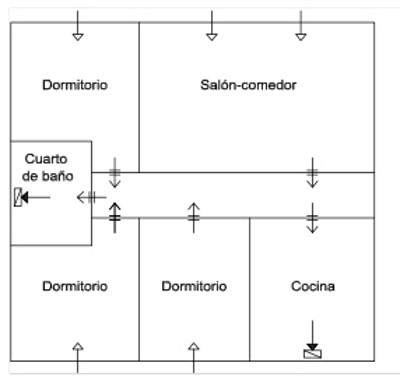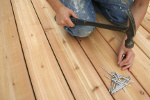Moisture and condensation nuisance in houses in Spain
Paul Draaijer, Arquitecto, Sunday, 26 November 2017
Mould formation on walls and ceilings
We regularly receive the assignment to carry out technical research reports, which give the prospective buyer the certainty that there are no hidden defects hidden in his home. Separate single-family houses built on the Spanish coasts from the 1970s onwards have generally been built in a traditional manner and have, in the vast majority of cases, a reinforced concrete supporting structure which has generally withstood the times. In many of these houses, however, we encounter problems in the area of moisture and condensation nuisance, which are usually revealed rather quickly by a typical stale smell in the house, especially if this has been uninhabited for some time, and which in the worst cases is caused by mould formation on walls and ceilings. These phenomena naturally create an unhealthy indoor climate and can even lead to serious health problems in the long run.
Cause of these problems
Further research almost always shows that the cause of these problems can be found in:
Mould formation on walls and ceilings
We regularly receive the assignment to carry out technical research reports, which give the prospective buyer the certainty that there are no hidden defects hidden in his home. Separate single-family houses built on the Spanish coasts from the 1970s onwards have generally been built in a traditional manner and have, in the vast majority of cases, a reinforced concrete supporting structure which has generally withstood the times. In many of these houses, however, we encounter problems in the area of moisture and condensation nuisance, which are usually revealed rather quickly by a typical stale smell in the house, especially if this has been uninhabited for some time, and which in the worst cases is caused by mould formation on walls and ceilings. These phenomena naturally create an unhealthy indoor climate and can even lead to serious health problems in the long run.
Cause of these problems
Further research almost always shows that the cause of these problems can be found in:
- inadequate or poorly insulated cavity wall insulation
- defective window frames without cold bridge interruption
- bad or not at all insulated roller blinds
- Insufficient protection against rising moisture from the ground
- insufficient permanent ventilation of the housing
Permanent ventilation of the house
In order to solve the problems, in principle all the causes mentioned can be addressed. However, as cost considerations also need to be taken into account, a step-by-step approach is often chosen. The easiest, often immediately effective, operation is to provide permanent ventilation of the house. The principle of this can be well demonstrated with the following scheme from the Spanish construction decree:

The ventilation flow through the house is based on the inlet of fresh air through the outside wall of dry rooms (open arrows: bedrooms, living room), must be able to circulate through intermediate doors (arrows with double transverse lines) and is discharged through exhaust grilles in the wet rooms (sealed arrows: bathroom and kitchen).
All rooms, except the bathroom, must also have natural ventilation via window or door. The kitchen must also be equipped with an extractor hood.
In older houses, where this ventilation is in most cases not provided, it is relatively easy to install special ventilation grilles with acoustic sound attenuation which, if correctly installed, can greatly reduce moisture and condensation problems.
Author : Paul Draaijer, Architect
Mendez Nunez 8,2 E-43004 Tarragona
T. + 34. 977.227.214
info@pauldraaijer.com

Spanish property for sale. Appartements, villas and housesfor sale in Spain Costa del Sol, Costa Brava and Costa Blanca. For sale by owner and by agent.
 For a renovation project in Spain, you need time, patience, perseverance and above all money. In this post, you will find some tips. A motivated agent
is crucial, also a budget that takes into account setbacks and a good lawyer.
For a renovation project in Spain, you need time, patience, perseverance and above all money. In this post, you will find some tips. A motivated agent
is crucial, also a budget that takes into account setbacks and a good lawyer.